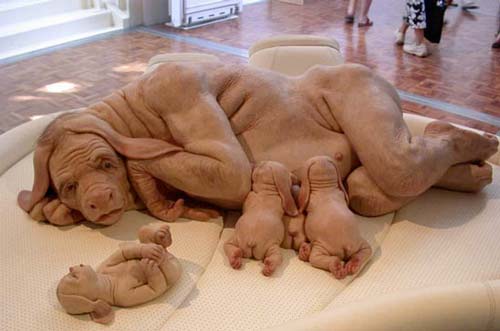The Human-Dog Hybrid Hoax

Those concerned with cloned and genetically modified animals often ask: Have scientists gone too far? What are the implications of new frontiers in genetics?
One horrific answer appeared recently in a widely-circulated story: "Israeli scientists are examining what appears to be a trans-species between a Labrador retriever and human. While genetically considered impossible, humane workers found remains of an earlier trans-species, believed to be the parent of the animal pictured above, shallow buried in the owner's property. The human parent of the animals is believed to be the teen-aged son of the family well known in politics. DNA studies are in process and results are expected early next month."
It was accompanied by a photo of what appeared to be a strange half-woman, half-dog (or pig) hybrid mother nursing its young. The image has flooded inboxes around the world, accompanied by messages—some satirical, others clearly serious — often suggesting that the image is a horrific warning of the consequences of genetic manipulation (or, perhaps, bestiality).
Of course this hybrid doesn't exist. It's not an actual animal but instead a sculpture by artist Patricia Piccinini, from her 2003 exhibition "We Are Family."
It's not clear how many people were actually fooled by the photograph — it's likely that many simply forwarded the image (or a link to the image) to friends as timekilling curiosity instead of a dire warning. The Snopes Urban Legend Web site debunked this photograph back in 2007, though the humanpigdog photo has a life of its own and will likely continue to be resurrected from time to time, either accidentally or intentionally as a hoax.
People love a mystery, and people especially love a mystery that comes with a weird photo.
The Half-Human Hybrid hoax is only the latest in a long series of supposedly mysterious photos. Typically these photographs have three elements in common: They are at least somewhat realistic; they are odd or strange enough to attract curiosity; and perhaps most importantly, they are misidentified.
Sign up for the Live Science daily newsletter now
Get the world’s most fascinating discoveries delivered straight to your inbox.
How do these things get started?
Often, as in this case, there is no intentional hoaxing: It is a legitimate, straightforward photograph of something curious. Often the photographs were created as an art project, as was the case with the Borneo Monster image that circulated (and which I helped disprove) in February. Many artworks, such as those by Piccinini and hyperrealist sculptor Ron Mueck, could easily be mistaken for a bizarre, seemingly mysterious phenomenon when seen out of context.
Other times the subject is real but presumably unknown to the photographer, as was the case with the Montauk Monsters (aka decaying raccoons) found in July 2008 and May 2009. After all, it's much easier to create a "mystery photo" than a half-human hybrid.










